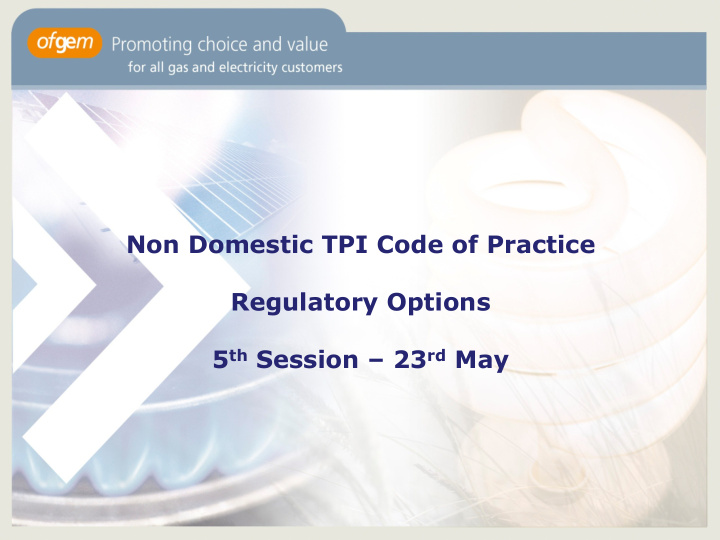



Non Domestic TPI Code of Practice Regulatory Options 5 th Session – 23 rd May
There are a number of decisions needed, other than on the contents of the Code Administrative structure (where do the administrators What is the of the Code sit, and how are Where do process for they funded) complaints joining? Regulatory go and who rules on structure them? (how are TPI’s tied to the code) Today we focus our discussion on the Regulatory structure 2
Regulatory Options – There is a wide spectrum of options Option 3 Option 2 Option 1 Option 4 Code of Practice Voluntary Code of Code of Practice Licence TPIs Practice SLC accreditation No cost to be a Minimal cost to be a High level of Cost to be a member member member regulatory intervention No Strong sanctions for Strong sanctions for Audits/Sanctions will be Audits/Governance/No bad behaviour bad behaviour part of the code sanctions /breaches /breaches Will cover ALL TPIs May not cover all TPIs May not cover all TPIs Will cover ALL TPIs Will require a change in Reliant on TPIs Significant costs Significant cost for a both TPI/Supplier adopting the Code proportion of TPIs associated for TPIs behaviour Longer implementation Longer implementation Quick implementation Quick implementation timetable timetable 3
Discussion Option 2 : “Narrow and Deep” Voluntary Code Narrow: Cost to belong to the CoP, would not include all TPIs Deep: Strong auditing and monitoring regime Would rely on strong consumer brand awareness, main sanction ‘to be excluded from Code’ Monitor and Level of enforce – Will intervention – induce change BUT...... Practicality – Low to Medium Easy • Cost to sign • Would • Training records up to the not • Regular audits of code. • Easy to code members capture • Strict implement • External audit by approach for all ‘bad • Broad scope independent accreditation. which should elements appointee • May be allow ease • How • Limited restricting for when much sanctions for sole trader. implementing improve bad behaviour to current • Behaviours ment on market • BPMMRs will be required in processes an additional now? code are regulatory beneficial to option the consumer 4
Accreditation life cycle TPI applies for accreditation TPI to meet Enforcement/ standards Sanctions required to be accredited Code of Practice Accreditation Compliance Added to the list approved/breached of accredited organisations Maintain Audit/Complianc standards of e reviews accreditation 5
Discussion Option 3 : “Broad and Shallow” Code of Practice backed by supply licence requirement to only use accredited TPIs Broad: Minimal cost to join Shallow: No auditing but investigation of complaints and very strong implications of sanctions (risk to livelihood) Level of Monitor and Practicality- BUT...... intervention enforce- Medium -Medium Reactive • Will this • Minimal cost to sign • More difficult to • Training records up to the code. implement than • Audits internally by continue to option 2 • Lighter approach for code members highlight and accreditation. • Behaviours required • No external audits capture rogue in code are beneficial • All TPIs would need • Strong sanctions for to the consumers practices? to be registered and bad behaviour identifiable • Require a change in • BPMMRs will be an supplier/TPI • Less restricting for additional regulatory behaviour smaller entities than option Option 2 • Require up to date register and alerts to suppliers when a TPI is sanctioned. 6
Which option best aligns customer protection and proportionality? Some suggested Pro’s and Con’s Option 2 Option 3 Intervention – Low/Medium Intervention - Medium • Pros • Pros • Easiest option to implement • Stronger potential sanctions than option • Quickest option to implement 2 • Broad scope of Code of Practice will • Smaller cost to become a member cover the ‘TPI’/‘Consumer’ Journey • More acceptable level cost to TPIs? • Wider TPI coverage • Cons • Will reduce rogue practice – long term • Will not include all TPIs • Strong auditing and monitoring regime – Could be costly • Cons • Will not capture all ‘bad elements’ of the • Could affect new market entrants market, if they don’t join. • Negative effect on competition if TPIs do • Would rely on strong consumer brand not sign up to the CoP awareness as a draw card for • Less audit intervention may see an initial membership rise in rogue practice 7
Recommend
More recommend